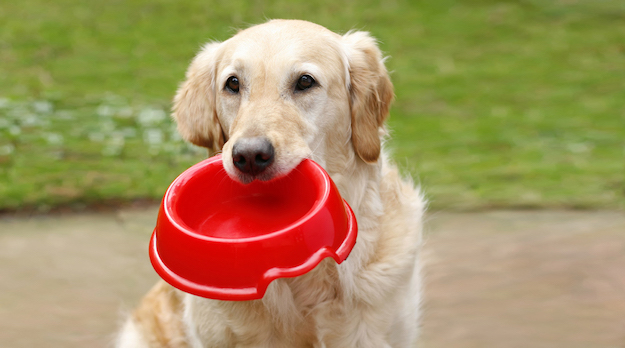7 Tips to Properly Calculate Your Dog’s Meal Portions

Overfeeding pets is obviously contraindicated, while pets fed too little can have nutritional deficiencies. Several factors must be considered when calculating the amount, you feed your pet. Keep reading to learn our tips for properly calculating your dog’s meal portions to ensure they receive the appropriate amount.
#1: Do Not Rely on Your Dog’s Feeding Label
The recommended food amounts on your dog’s food label are an estimate and are frequently an overestimate of an adult dog’s calorie needs. These general recommendations do not consider your dog’s individual caloric requirements, which are based on their age, breed, weight status, activity level, and neuter or spay status. Use the label as a starting point, but don’t assume the recommendations are accurate for your dog. Your veterinarian is a great resource; talk to your doctor at your next visit.
#2: Determine Your Dog’s Body Conditioning Score
A body conditioning score (BCS) is a subjective method of evaluating your dog’s body fat. After your doctor has visualized and palpated your pet, they are assigned a score from one to nine, where one is extremely emaciated and nine is extremely obese. Scoring descriptions include:
- Emaciated — The dog’s ribs, lumbar vertebrae, pelvic bones, and bony prominences are evident from a distance. They have no discernible body fat, and muscle loss is obvious.
- Very thin — The dog’s ribs, lumbar vertebrae, and pelvic bones are easily visible. They have no palpable fat, and minimal muscle loss.
- Thin — The dog’s ribs are easily palpated and may be visible. The lumbar vertebrae and pelvic bones are prominent, and the dog’s waist is evident.
- Ideal weight — The dog’s ribs are easily palpated and have minimal fat covering. The dog’s waist is evident when viewed from above, and their abdomen is tucked up when viewed from the side.
- Ideal weight — The dog’s ribs are palpable without excess fat. Their waist is evident when viewed from above, and their abdomen is tucked up when viewed from the side.
- Overweight — The dog’s ribs are palpable under a slight fat covering. Their waist and abdominal tuck are discernible but not prominent.
- Heavy — The dog’s ribs are difficult to palpate under a heavy fat covering. Noticeable fat deposits are present over the lumbar area and at the tail base. The waist is absent or barely visible, and a slight abdominal tuck is present.
- Obese — The dog’s ribs are not palpable under a heavy fat covering. Heavy fat deposits are present over the lumbar area and at the tail base. The waist and abdominal tuck are absent, and obvious abdominal distention is present.
- Severely obese — Massive fat deposits are present over the dog’s body, spine, and tail base, and may also be present on the neck and limbs. The waist and abdominal tuck are absent, and obvious abdominal distention is present.
#3: Calculate Your Dog’s Daily Energy Requirements
Using your dog’s specifications, calculate their daily energy requirements—an online calorie calculator can make this step a little easier. You will need to know your pet’s current weight, and their ideal weight, and you will also be asked to provide information such as their BCS, species, and spay or neuter status. Once you know your dog’s daily caloric needs, you can determine how much food they need. The dog food label usually lists the number of calories as calories per cup or calories per kilogram. The calorie calculator provides your dog’s caloric needs for an entire day, so if you feed your dog multiple times a day, ensure you divide the results appropriately.
#4: Measure Your Dog’s Meal Portions
Eyeballing your dog’s meal portions can mean significantly different portion sizes. Use a measuring cup or a kitchen scale to accurately measure your dog’s portion size, to ensure you give them the correct amount. This is especially important for small-breed dogs because a few kibble pieces can be a substantial percentage of their total caloric needs.
#5: Factor in Your Dog’s Treats
You should limit your dog’s treats to no more than 10% of their daily calories, and ensure you include these calories in your dog’s overall daily energy requirements. If your dog’s treats don’t list a calorie count, ask the company for the exact calorie amount—you likely will be surprised at the number of calories packed in some popular dog treats.
#6: Monitor Your Dog’s Weight Status
Weigh your dog and assess their BCS every two to four weeks. Track the results, so that you notice inappropriate weight changes and can adjust their portion sizes accordingly. You may also need to adjust your dog’s portion sizes as they age, because senior pets typically have a slower metabolism. In addition, adjust your dog’s meal sizes if an injury or illness prevents them from their usual amount of activity.
#7: Talk To Your Veterinarian
Anytime you have questions or concerns about your dog’s weight status or diet, talk to your veterinarian. Their knowledge and expertise ensure they will provide the best advice for your dog’s needs. Whether your dog is healthy and in the prime of their life or dealing with a medical issue requiring a specialized diet, you should always turn to your veterinarian for advice on your pet’s dietary requirements. They can also help devise a safe weight loss program if your dog needs to lose a few extra pounds and determine if a health condition is causing an unexpected weight loss.
Appropriately calculating your dog’s energy requirements and feeding them the correct amount will best maintain their ideal weight to keep them healthy. If you have questions or concerns about your dog’s dietary needs, contact your veterinarian for specific advice about their individual requirements.